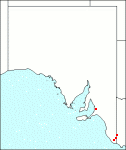Family: Poaceae
Setaria gracilis
Citation:
Kunth in Humb., Bonpl. & Kunth, Nov. Gen. et Sp. Pl. 1:109 (1816) var. pauciseta (Desv.)B. Simon, Austrobaileya 2:22 (1984).
Synonymy: Panicum geniculalutn Lam., Encycl. 4:727 (1798); S. geniculata (Lam.)P. Beauv., Agrost. 51 (1812) var. pauciseta Desv. in C. Gay, Fl. chilena 6:248 (1854).
Common name: Slender (or bent) pigeon-grass.
Description:
Perennial, to 60 cm tall, the stems geniculate near the base; leaf sheaths loose, the blades flat, more or less glabrous, 5-8 mm broad; ligule shortly ciliate.
Panicle spike-like, cylindrical, 2-10 cm long, 4-5 mm diam. (including the bristles), yellowish or purplish, with short branches; spikelets ovate-ellipsoid, 2-2.5 mm long; bristles 6-8, up to twice the length of the spikelet; first glume little more than half the length of the spikelet, ovate, rather acute, 3-nerved, second flume shorter than the spikelet; first lemma as long as the spikelet, with a small palea, second (fertile) lemma about as long as the spikelet, transversely rugulose.
Published illustration:
Burbidge (1970) Australian grasses 3:pl. 63; Cunningham et al. (1982) Plants of western New South Wales, p. 138.
|
|
Distribution:
|
Introduced as a pasture grass and occurs as a weed.
all mainland States except the N.T. Native to tropical and South America.
|
Conservation status:
naturalised
Flowering time: Jan., Feb.
|

SA Distribution Map based
on current data relating to
specimens held in the
State Herbarium of South Australia
|
Biology:
No text
Author:
Not yet available
|

